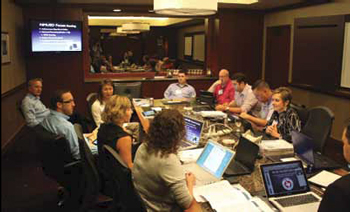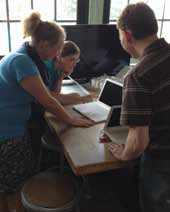Professional Development

The great news on the PD front—at least from the districts who presented at the second School CIO Summit Conference this June—is that we’ve moved far away from the days of drive-by PD in which socalled experts come in once a year to show teachers how to use product X and expect them to begin using it perfectly by the very next day. These forward-thinking districts are surveying teachers to find out what they want to learn, customizing their offerings, and trying to provide individualized learning opportunities. A couple have begun flipping the PD model in the same way they’re encouraging teachers to flip their classrooms. And all of them are gathering post-course data to fine-tune their offerings even more. Take a glimpse at PD 3.0.
Eanes Independent School District, TX
Presenter: Carl Hooker, Director of Instructional Technology
What makes teachers want to take a break from beach trips or finally tiling that living room floor? Fulfilling their hierarchy of needs when it comes to learning.
Eanes ISD is located in Austin, TX— also home to the oh-so-hip South by Southwest Film Festival—so it’s no surprise the district is leading the cause for the next wave of PD. From its flipped PD project to its iPadpalooza, Eanes is writing the book on how to make PD relevant, enticing, personalized, and meaningful.
For the flipped PD project, teachers watch videos to learn how to use Google Docs, Edmodo, or iMovie. Then they spend face-to-face time with their colleagues to integrate those tools into their lessons and complete one activity to receive PD credit.
One program hosted by the district is called Eanes Interactive. This one-day event features multiple teacher-led sessions on how to infuse technology into the classroom. This year’s event included sessions on classroom management for iPad immersion and real-time assessment using the iPad.
Another popular program is the Apple Core Academy. This three-day intensive, invitationonly session covers everything teachers must know about using Macs and iPads. This summer, attendees created an eBook of the “Apptivities” they created during the Academy. The eBook will be used as a resource for other teachers in the district who are implementing 1:1 iPads.
Tools and ideas to transform education. Sign up below.
At the first iPadpalooza in June, more than 500 attendees (200 of whom were Eanes employees) from 70 districts chose from 40 sessions on everything from iPad tech support to must-have apps for busy administrators to one course named, “I have iPads; Now how do I change instruction?”
Tools They Use
Apple TV
Edmodo
Google Docs
iPads
iMovie
MacBook Pros
Without a comfortable learning environment where risk taking is encouraged and failure is cheered, learners will never have a chance to reach their highest level.
Additional Participants:
Scott Bailey
Chief Academic Officer, Washoe County Schools, NV
Karen Fuller
Chief Technology Officer, Klein Independent School District, TX
Antone Inglese
Chair, State Tech Committee, Batavia Public Schools, IL
Suzette McIntyre
Technology Director, Wall Independent School District, TX
Jane Woodburn
Deputy Superintendent, Washoe County Schools, NV
South Portland School Department (SPSD), ME
Presenter: Andrew Wallace, Director of Technology
“Be the change you want to see” is the PD motto at this district in Maine.

In Maine, where 100 percent of the middle schools and a majority of high schools are already implementing 1:1 technology, flipping is an effective instructional model that they have begun using for their PD.
Wallace says, “Flipping the PD offers many tangible benefits. By imbedding technology-driven instructional methods into our PD, we hope our teachers see how effective it can be and will weave into their own teaching.”
At SPSD, PD is rarely conducted in a computer lab, as schools continue to phase them out. The key is to have teachers learn on the laptop they will be using as they teach. Asking teachers to complete even one basic assignment before the PD session will generally send up a red flag if a new version of software is needed.
One of the best things about tools like Discovery Education Streaming or Atomic Learning for PD is that different educational videos can be assigned to different students, based on the individual learner’s needs and level of understanding. Teachers can frontload content knowledge for those students who may need a little remediation or for those who learn things differently. Once teachers experience technology-based differentiation in their own professional learning, they’ll be more inclined to use it in their classrooms.
SPSD allows teachers to drive the instruction by using a simple Google Form to poll participants. If the polling indicates that certain topics have already been mastered by all participants, then they can move ahead. Google Forms can also be used to gauge appropriate pace or as an anonymous check for understanding. The PD staff hopes teachers employ these tools as well when they return to the classroom.
Tools They Use
Moodle
Discovery Education Streaming
Atomic Learning
YouTube
Google Forms
Screenr or Screenflow with Blue “SnowBall” microphones for homemade how-tos
Dayton ISD, TX
Presenters: Mike Kurt, Superintendent; Peter Griffiths, Executive Director of Curriculum and Instruction
In 2011-2012, Dayton ISD focused its PD on experimentation, innovation, data, and differentiated instruction. After an intensive feedback-gathering project, the district learned that staffers wanted small-group, focused staff development and simplicity. To answer the call, Dayton offered eCourses through Eduphoria.
Through eCourses, teachers were able to get trained on specific expectations the district set up for the upcoming school year. Teachers enjoyed the flexibility. The district appreciated the compliance aspects and the price tag—there was no need to pay trainers to conduct training sessions. Once a teacher completed the necessary assignments, he or she received a credit for an exchange day.
To offer the small-group and personalized training, Dayton ISD implemented job-embedded PD (JEPD). The district curriculum department was able to go to individual campuses and focus on training that was designed for needs of the campus during teacher conferences. This helped the district get a lot of information from all the staff members without the cost of substitutes or after-school time when teachers are ready to just go home.
TOOLS THEY USE
Eduphoria
iPhones
iPads
Prepare 50 percent more content and activities than you will use in your PD session. You’ll be ready to teach the advanced class as soon as your colleagues request it.
Newport-Mesa USD, CA
Presenter: Jenith Mishne, Director of Education Technology
To fine-tune its PD offerings, NMUSD focused on answering three questions:
1. What is the role of online, blended, and flipped classes in PD?
Mishne’s team tries to make its content available on a wiki, Google Docs, or in Edmodo, allowing 24/7 viewing for staff and teachers. Then, when they meet, they have background knowledge. Sometimes, teams meet via Google+ Hangouts or Webex. As a result, face-toface time is engaging and collaborative, just like the district wants its teachers to be with their students. Mishne also provides opportunities for coaching and modeling—either in the classroom or during group discussions.
2. How is technology used to track staff development needs and progress?
Newport-Mesa’s educational services surveyed teachers to determine PD needs. They used data to figure out where teachers needed more training and met with administrators and teachers to gather qualitative data.
3. What are the most powerful PD solutions for tech implementations?
• Communication, Collaboration, and Coaching/Mentoring
• Edmodo
• Google+ Hangouts
• Wikis
• Google Docs
• Webex
• Access to Knowledge Base
• CustomGuide
• PDF and video (Snagit, Jing)
• Evaluation and Monitoring
Tools They Use
Custom Guide
Edmodo
Google Docs
Google+ Hangouts
iPhones & iPads
Snagit/Jing
Webex
Wikis
